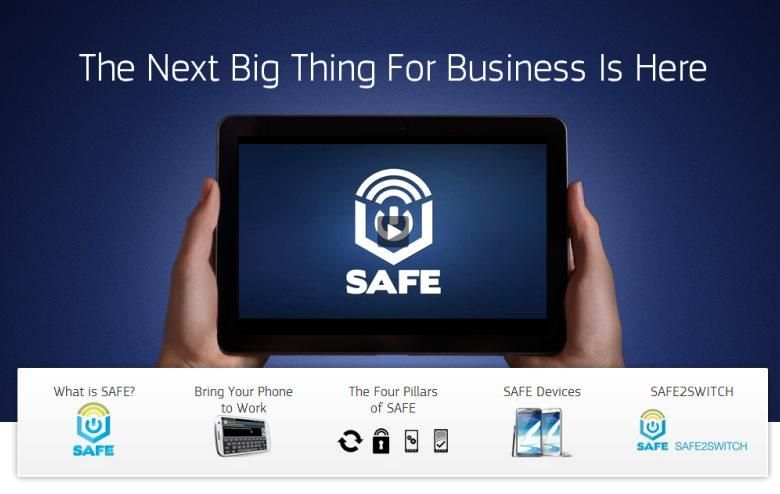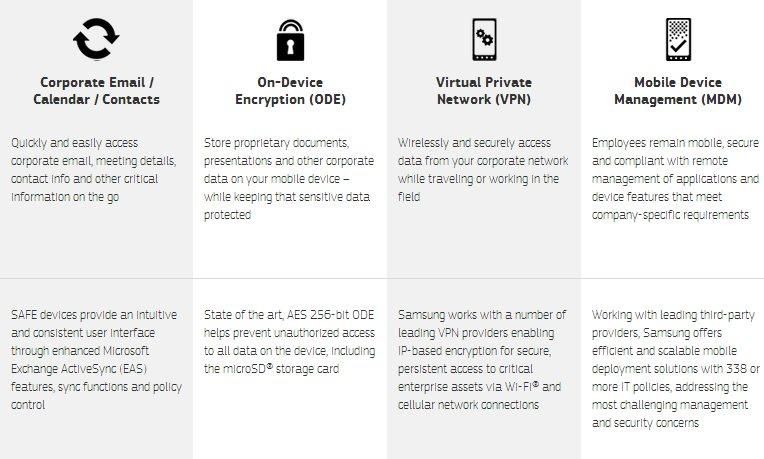We recently talked about smartphones, brand names, and saturation of the major players in the mobile arena, and the fact that handsets powered by Android make up over 50% of the market share. It may come as somewhat of a surprise to learn that when it comes to corporations, Android comes in around 26% — second to iOS at 37%.
Samsung doesn't like that is has a plan to do something about it. They're calling it SAFE — "Samsung Approved For Enterprise" or "Samsung For Enterprise" for short. SAFE is built on "four pillars": enabling workers to access their corporate email, calendar, and contacts from their device; on-device encryption to keep data safe in the event it's lost or stolen; Virtual Private Network (VPN) to securely access data on the corporate network from remote locations, even over Wi-Fi or cellular; and Mobile Device Management to handle remote configuration, wiping, and other management tasks.
All of these things, when combined under the Samsung SAFE logo, intend to send a message to executives and corporate IT departments.
With a logo like that, it must be good!
"We've seen this before," says Tim Wagner, VP and general manager of enterprise sales at Samsung. "Once desire becomes so large it's only a matter of time before (... a particular smartphone) becomes adopted in the enterprise."
I don't think you'll find many people who will argue that the Galaxy S III isn't "largely desirable" today.
According to their literature, "SAFE represents the growing family of Samsung Enterprise solutions that include the necessary security and feature enhancements suitable for business use. Highly desirable Samsung devices are safe to use at work, thanks to several features that keep company data secure."
All this sounds great and you're probably asking yourself which Samsung devices are "SAFE Certified" today. It's a short list: the Galaxy S III (in all its variants), and the Galaxy Note II. More devices will follow, but probably not any older ones. I suspect Samsung will only want to highlight these features on newer devices.
Ironically, that's all they are: features.
If you've got a smartphone or tablet running Android 2.3 Gingerbread or higher you've already got these features — unless your OEM or carrier took them out. Stop for a moment and ponder on that. Android version 2.3 on up through 4.2.2 all come with VPN, device encryption, and device management built in. That's three of the four "SAFE" pillars. The fourth is Microsoft Exchange and Active Sync functionality, which usually falls under the "Corporate" section in the Accounts settings. Most devices I've used include this ability through their calendar, contacts, and email apps. That's the fourth pillar.
Some carriers and/or OEMs, however, strip VPN, device encryption, and device management from their products because "you don't need them". Samsung, being either brilliant or stupid, built a campaign around them, complete with a fancy logo, advertising essentially what "pure" Android can already do.
Of course there are some differences, and Samsung advertising the fact that they have all these features (in select devices) won't hurt Android adoption in the enterprise. After all, corporate suits don't seem to like whitepapers explaining what things can do and what features come baked in. They line logos, they like graphs, they like someone else putting their neck on the like to say "hey, we're secure, choose us". And that's just what Samsung has done. Do you feel SAFEr?
Sources: Good Technology, Samsung



